 Nokia has launched three new Nseries mobile multimedia handsets, capable of taking print-quality pictures, playing MP3s, reading e-mail, browsing the Web sites and viewing mobile TV.
Nokia has launched three new Nseries mobile multimedia handsets, capable of taking print-quality pictures, playing MP3s, reading e-mail, browsing the Web sites and viewing mobile TV.
They might sound like a collection of night buses, but Nokia’s N90, N91 and N70 phones could represent a major step forward in multimedia mobile convergence.
“This next step in digital convergence brings together mobile devices, Internet content, still and video cameras, music, email and much more. Nokia Nseries devices share similar design traits as mobile phones, but they are actually powerful pocketable computers with a comprehensive set of multimedia features,” said Anssi Vanjoki, Executive Vice President, Multimedia, Nokia.
Nokia N91
The Nokia N91 multimedia handset looks to be facing up to Apple’s iPod, offering a two megapixel camera, Bluetooth and a 4-gigabyte hard disk, (capable of storing up to 3,000 CD-quality songs) inside its natty stainless steel case.
Serving up to 12.5 hours of sound via the included remote-control headset, the Nokia N91 supports a wide range of digital music formats including MP3, M4A, AAC and WMA.
Playback is made easy with dedicated music keys on the phone’s face, which slides down to reveal the phone keypad.
“The Nokia N91 delivers both a fantastic music experience and cutting-edge phone features,” purred Jonas Geust, Vice President, Music at Nokia. “What sets the Nokia N91 apart is the fact that it is always connected – you can download new music while on the move, add it to your favourite playlist and then share your playlist with friends. It’s truly the world’s best mobile connected jukebox.”
 Nokia N90
Nokia N90
The N90 features a twister-tastic, rotating camera barrel which fires up the phone’s 2 megapixel camera (with Carl Zeiss lens), offering autofocus, an integrated flash and 20x digital zoom.
The tri-band phone’s main display has a 352 x 416 pixel screen (262,144 colours), with a secondary 128 x 128 pixels display on the front.
With its pioneering multi-hinge twist-and-shoot design, we have brought ease-of-use and high quality photography into mobile telephony,” enthused Juha Putkiranta, senior vice president of multimedia imaging at Nokia.
Using the main screen as a viewfinder, the N90 can capture high quality video in MP4 format, with a 8x digital zoom.
 Images, videos and sound can be stored on the phone’s internal 31 MB memory or on the supplied 64 MB RS-MMC
Images, videos and sound can be stored on the phone’s internal 31 MB memory or on the supplied 64 MB RS-MMC
The 3G-enabled N90 is expected to be the first to hit the market this summer, with a suggested retail price for the N90 is €700 (~US$909 ~£474),
Nokia N70
Finally, the 3G-enabled Nokia N70 once again features a 2 megapixel camera, flash and front camera for video calling, with a FM radio, a digital music player and new 3D games.
The camera is activated by a rear sliding cover, with a range of capture scene settings available, including Scenery, Portrait, Night, and Sports.
 Joe Coles, Director of imaging product marketing at Nokia, stressed the consumer demand for camera-enabled mobiles: “The number one reason why people today purchase new handsets is the camera. Indeed, we foresee that by the end of 2005, over half a billion people worldwide will own a camera phone.”
Joe Coles, Director of imaging product marketing at Nokia, stressed the consumer demand for camera-enabled mobiles: “The number one reason why people today purchase new handsets is the camera. Indeed, we foresee that by the end of 2005, over half a billion people worldwide will own a camera phone.”
Measuring a diminutive 108.8 x 53 x 17.5 mm, the Nokia N70 is the smallest ever 2 megapixel 3G smartphone based on the Series 60 Platform and is expected to be available in the third quarter of 2005.
This new range of innovative phones represent further evidence of the convergence of consumer devices, with mobile phone makers keen to get a lion size bite of the action.
Nokia already claims to the biggest camera vendor in the world, and anticipates that these new phones will help secure its position as the largest seller of portable MP3 players later this year.
Nokia
Samsung’s Hard Drive Phone
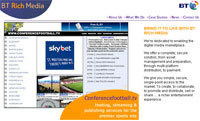 BT Rich Media has cuddled up to Sportfive, a French sports marketing group, and announced a partnership to make 2006 Football World Cup qualifying and friendly games available to fans streamed over broadband on the Internet.
BT Rich Media has cuddled up to Sportfive, a French sports marketing group, and announced a partnership to make 2006 Football World Cup qualifying and friendly games available to fans streamed over broadband on the Internet. Football bonkers viewers will be able to choose between 250Kbps or 500Kbps quality streams for approximately £7 (~US$13 ~€10), or alternatively download the entire match to keep forever for around £5 (~US$9.50 ~€7). As a long suffering Wales fan, I have to admit that there’s several games which I never wish to see again!
Football bonkers viewers will be able to choose between 250Kbps or 500Kbps quality streams for approximately £7 (~US$13 ~€10), or alternatively download the entire match to keep forever for around £5 (~US$9.50 ~€7). As a long suffering Wales fan, I have to admit that there’s several games which I never wish to see again! The games will be served up on http://www.qualifiers2006.com and promoted to over 10 million users via a range of affiliate sites such as soccernet.com,.teamtalk.com, sportinglife.com and rivals.net .
The games will be served up on http://www.qualifiers2006.com and promoted to over 10 million users via a range of affiliate sites such as soccernet.com,.teamtalk.com, sportinglife.com and rivals.net .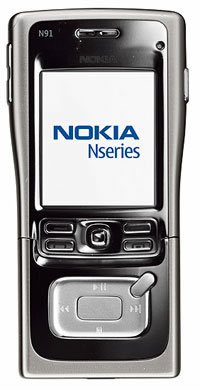 Nokia has launched three new Nseries mobile multimedia handsets, capable of taking print-quality pictures, playing MP3s, reading e-mail, browsing the Web sites and viewing mobile TV.
Nokia has launched three new Nseries mobile multimedia handsets, capable of taking print-quality pictures, playing MP3s, reading e-mail, browsing the Web sites and viewing mobile TV.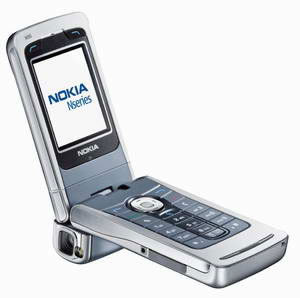 Nokia N90
Nokia N90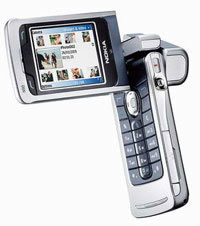 Images, videos and sound can be stored on the phone’s internal 31 MB memory or on the supplied 64 MB RS-MMC
Images, videos and sound can be stored on the phone’s internal 31 MB memory or on the supplied 64 MB RS-MMC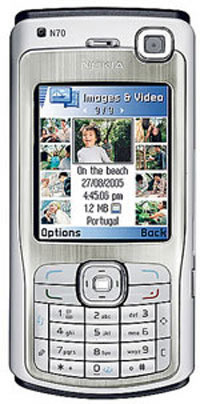 Joe Coles, Director of imaging product marketing at Nokia, stressed the consumer demand for camera-enabled mobiles: “The number one reason why people today purchase new handsets is the camera. Indeed, we foresee that by the end of 2005, over half a billion people worldwide will own a camera phone.”
Joe Coles, Director of imaging product marketing at Nokia, stressed the consumer demand for camera-enabled mobiles: “The number one reason why people today purchase new handsets is the camera. Indeed, we foresee that by the end of 2005, over half a billion people worldwide will own a camera phone.”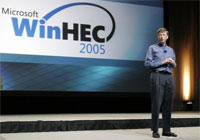 After several years of delays, Microsoft has assured computer-makers that Longhorn, the next version of Windows, is on track for release by the end of next year.
After several years of delays, Microsoft has assured computer-makers that Longhorn, the next version of Windows, is on track for release by the end of next year. This would offer a built-in method to let users view and print graphical documents, without the need to install the application that created the original file – in other words, a rival to Adobe Systems’ popular PDF technology and PostScript page description language.
This would offer a built-in method to let users view and print graphical documents, without the need to install the application that created the original file – in other words, a rival to Adobe Systems’ popular PDF technology and PostScript page description language. AbbiTalk, a West Sussex-based provider of Voice Over IP (VoIP) telephony services, is talking tough about its cut-rate broadband call packages, that offer customers extra telephone lines with discount local and UK call charges and no line rental.
AbbiTalk, a West Sussex-based provider of Voice Over IP (VoIP) telephony services, is talking tough about its cut-rate broadband call packages, that offer customers extra telephone lines with discount local and UK call charges and no line rental.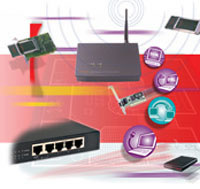 Prices start at £149 for “AbbiTalkBasicOne”, which provides one extra phone line, a unique number with Pre Pay phone account, an adaptor and a DECT digital cordless phone with digital answering machine.
Prices start at £149 for “AbbiTalkBasicOne”, which provides one extra phone line, a unique number with Pre Pay phone account, an adaptor and a DECT digital cordless phone with digital answering machine. No line rental is charged and there’s no need to use a computer to make the calls as these are accomplished through the standard cordless handsets.
No line rental is charged and there’s no need to use a computer to make the calls as these are accomplished through the standard cordless handsets.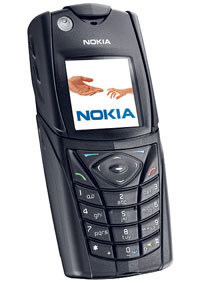 Sweatband-toting sporty types will be pleased to learn that Nokia has introduced a new handset for active-minded consumers, the Nokia 5140i camera phone.
Sweatband-toting sporty types will be pleased to learn that Nokia has introduced a new handset for active-minded consumers, the Nokia 5140i camera phone.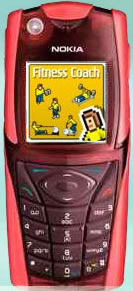 Water-bottle clutching joggers will appreciate the ‘Fitness Coach’ application, offering an ‘always-on’ personal trainer that (apparently) “encourages users to go the extra mile or finish the last set.”
Water-bottle clutching joggers will appreciate the ‘Fitness Coach’ application, offering an ‘always-on’ personal trainer that (apparently) “encourages users to go the extra mile or finish the last set.”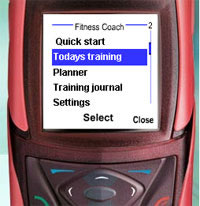 The phone also includes the
The phone also includes the  BBCi has launched a programming service for digital satellite viewers showcasing short films made by ordinary folk across the UK.
BBCi has launched a programming service for digital satellite viewers showcasing short films made by ordinary folk across the UK. Video Nation broke new ground when it first hit UK TV screens – running in short slots dropped in to the programming schedule.
Video Nation broke new ground when it first hit UK TV screens – running in short slots dropped in to the programming schedule. Content on the ‘Your Stories’ service is divided into daily themes, each with its own title. “My Music”, for example, featured an eight-year-old trumpet player and a blind pianist.
Content on the ‘Your Stories’ service is divided into daily themes, each with its own title. “My Music”, for example, featured an eight-year-old trumpet player and a blind pianist.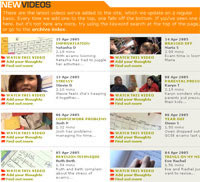 BBCi controller, Rahul Chakkara, explained the reasoning behind Your Stories service: “The BBCi audience is maturing, and is looking for content that is social and highly involving, available to them whenever they want.”
BBCi controller, Rahul Chakkara, explained the reasoning behind Your Stories service: “The BBCi audience is maturing, and is looking for content that is social and highly involving, available to them whenever they want.”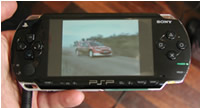 Big sighs of disappointment are heard all around Europe, as Sony officially announce the released date of the handheld gaming/media dream machine, the Sony PSP. It’s going to be 1 September 2005.
Big sighs of disappointment are heard all around Europe, as Sony officially announce the released date of the handheld gaming/media dream machine, the Sony PSP. It’s going to be 1 September 2005. Sony have announced the PlayStation Portable Value Pack at €249 (£179/US$323), which includes headphones, a 32Mb Memory Stick Duo, power supply, protective pouch, etc. The hit film Spider-Man 2 will be available on a UMD disc, free to early purchasers of PSP when they register on YourPSP.com.
Sony have announced the PlayStation Portable Value Pack at €249 (£179/US$323), which includes headphones, a 32Mb Memory Stick Duo, power supply, protective pouch, etc. The hit film Spider-Man 2 will be available on a UMD disc, free to early purchasers of PSP when they register on YourPSP.com.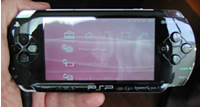 There are many tales of PSP-owners modifying their pride and joy to browser the Internet via Wi-Fi, or indeed run Instant Messaging client software.
There are many tales of PSP-owners modifying their pride and joy to browser the Internet via Wi-Fi, or indeed run Instant Messaging client software. Ericsson has reported a thumping great rise in quarterly profits, helped by the deployment of 3G networks.
Ericsson has reported a thumping great rise in quarterly profits, helped by the deployment of 3G networks.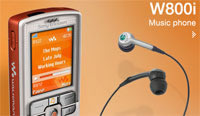 These figures fly in the face of predictions from investors and analysts that sales would drop steadily for the big telecoms firms as Chinese manufacturers took over the industry.
These figures fly in the face of predictions from investors and analysts that sales would drop steadily for the big telecoms firms as Chinese manufacturers took over the industry. In a quest to blast their already soaring profits further up into the stratosphere, Google will test a cost-per-impression bidding model for AdWords ads, letting advertisers specify groups of sites or specific sites in Google’s ad network.
In a quest to blast their already soaring profits further up into the stratosphere, Google will test a cost-per-impression bidding model for AdWords ads, letting advertisers specify groups of sites or specific sites in Google’s ad network. Google has, however, promised limitations on the animated advertising fluff that can appear on their adverts, with blinking ads that continuously loop already declared verboten.
Google has, however, promised limitations on the animated advertising fluff that can appear on their adverts, with blinking ads that continuously loop already declared verboten. The search engine heavyweights are hoping that the approach will appeal to advertisers who are fussy about where their brand appears or are aiming for a certain niche demographic.
The search engine heavyweights are hoping that the approach will appeal to advertisers who are fussy about where their brand appears or are aiming for a certain niche demographic.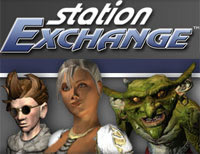 In an astonishing volte-face, Sony Online Entertainment (SOE) has announced that it now endorses the auctioning of virtual items from its massively popular online game, Everquest II – with the electronics giant pocketing a cut of the cash, naturally.
In an astonishing volte-face, Sony Online Entertainment (SOE) has announced that it now endorses the auctioning of virtual items from its massively popular online game, Everquest II – with the electronics giant pocketing a cut of the cash, naturally. Personally, we’d rather buy a round of lovely real ale than shell out for the Dark Lord of Deltronia’s Mystical Turbo Sword of Mwegneli, but as we’ve reported before (
Personally, we’d rather buy a round of lovely real ale than shell out for the Dark Lord of Deltronia’s Mystical Turbo Sword of Mwegneli, but as we’ve reported before ( “There already is a ‘virtual class system’ within the game itself – you earn status and faction standing, money, prestige, titles, fancy clothes and transport, you start living in a hovel but can move on up to luxury apartments etc – But at least till now you could assume that most people had ‘earned’ those things by playing the game.
“There already is a ‘virtual class system’ within the game itself – you earn status and faction standing, money, prestige, titles, fancy clothes and transport, you start living in a hovel but can move on up to luxury apartments etc – But at least till now you could assume that most people had ‘earned’ those things by playing the game.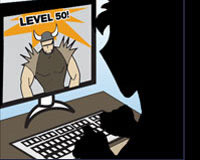 “I’m not sure of the mechanics in EQII, but in WoW (World of Warcraft) they have mitigated the potential for selling items somewhat by introducing the concept of having things bind to that character when it is picked up, meaning you can’t transfer items to other players, hence no selling though eBay and the like.”
“I’m not sure of the mechanics in EQII, but in WoW (World of Warcraft) they have mitigated the potential for selling items somewhat by introducing the concept of having things bind to that character when it is picked up, meaning you can’t transfer items to other players, hence no selling though eBay and the like.” For some gamers, an officially sanctioned auction site is an inevitable consequence of the growing popularity of virtual gaming, with Sony’s cut, a reasonable price to pay for eliminating a lot of scams.
For some gamers, an officially sanctioned auction site is an inevitable consequence of the growing popularity of virtual gaming, with Sony’s cut, a reasonable price to pay for eliminating a lot of scams.